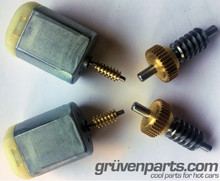 Loading... Please wait...
Loading... Please wait...12V VR6 Coil Pack Repair
Please give credit where credit is due! This DIYs completed ENTIRELY by the hardest VIDrking VW Vortex moderator on the site!! Gary Thompson, Ph.D. - vortex ID VGRT6.email address vgrt6@yahoo.com.Please make sure to say thanks to Gary, and if you ever see him at a bar, buy em a beer. These DIY's are more complete than anything Bentley has ever witten!!
For anyone who is interested, here are the directions from the Bentley (MKIV Golf, Jetta, GTI pages 28a-13 and 28a-14) to test a VR6 (AFP) coilpack. Someone in another post asked how, but Iput it here in its own thread since it would be searchable.
Quote (some references to figures have been omitted):
IGNITION COILS AND POWER OUTPUT STAGE,TESTING (2.8L ENGINE,CODE:AFP)
Double-ended ignition coils are mounted in a common housing together with a power output stage. AFP engines use 3 double-ended coils.The power output stage takes the low power signal from the ECM and boosts it to a level usable by the ignition coils.The signal to fire a spark plug results in both sparks on that particular coil firing at the same time.One spark is ..wasted.. by the un-used cylinder because it occurs at a time when it is not needed.The other simultaneous spark is used to fire the mixture in a normal manner. The un-used spark causes no additional wear on the spark
plug because it occurs at a time when there is minimal heat and pressure on the spark plug.The power output stage cannot be directly tested, but the signal from the ECM along with power and ground can be easily tested as follows.
1.Disable ignition system by disconnecting 5-pin hamess connector from ignition coil power output stage.
2.Connect a digitalvoltmeter to across connector terminals 1 and 5. (My addition: Idon't have a scanner so Ican•t post the figures that go along with the procedure.Holding the connector so that the two indents on the interior of the connector are on the bottomJ terminal1is on the extreme left and terminalS is on the extreme right. Use this for determining the terminal positions for the rest of the procedure).
3.Switch on ignition and read voltage.If voltage is present proceed to next step. no voltage is present, check for breaks, high resistance or open circuits in the wiring.
Specification:
-Voltage supply- power output stage ••••.•.•.•11.5 Volts minimum
4.Switch off ignition.
5.Remove fuse 32 (for fuel injectors) from fuse panel.
6.Connect an LED test light (such as VAG 15278) to the disconnected hamess connector at terminals 2 and 5.
10129/13 A ease giw credit Yotlere credit is due
Caution:
- Use a high-quality digital automotive multimeter and an LED test light to make the tests. An analog (swing-needle) meter and conventional test light should not be used as they can damage components.
-Always connect and disconnect the ECM connector and meter probes with the ignition off to avoid damage to components.
7.Operate starter and check for a signal from the ECM. LED test light must flicker.
8.Repeat steps 6 and 7 with the LED test light in terminals 3 and 5, and 4 and 5.
-If LED test light flickers the signal from ECM is good.
-If test light does not flicker, check for break in wiring. If no faults are found, check ECM for DTCs
with a suitable scan tool.
The secondary(highvoltage) side of the ignition coil can also be checked with an ohmmeter.
1. Label and disconnect spark plug wires from coil pack.
2.Connect anaccurate ohmmeter betweenterminals 1 and 6 and take reading. Repeat for terminals 3 and 4 and for terminals 2 and 5.
Specification:
-Ignition coil (AFP engine) secondary resistance at 20C (6BF) ............3600 to 4400 ohms
If no faults are found with the supply voltage, impulse signal, wiring, and resistance at coil, then the ignition coil pack should be replaced.
Most Popular
-
1
-
2
-
3
-
4
-
5






